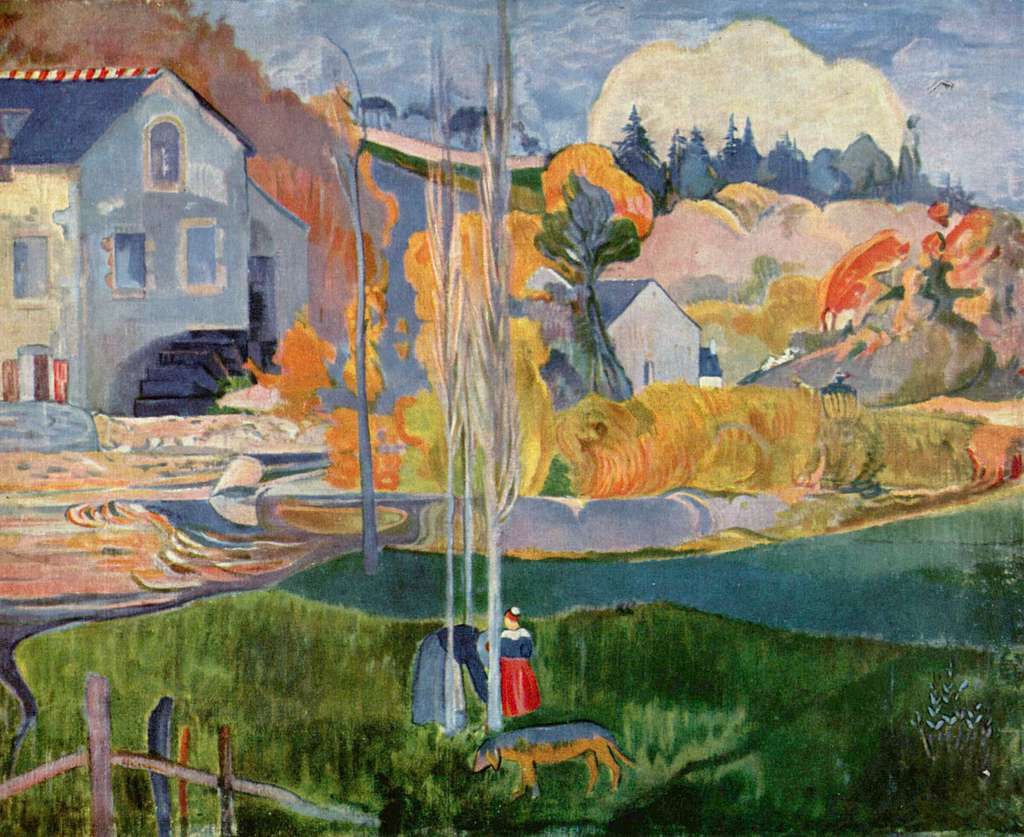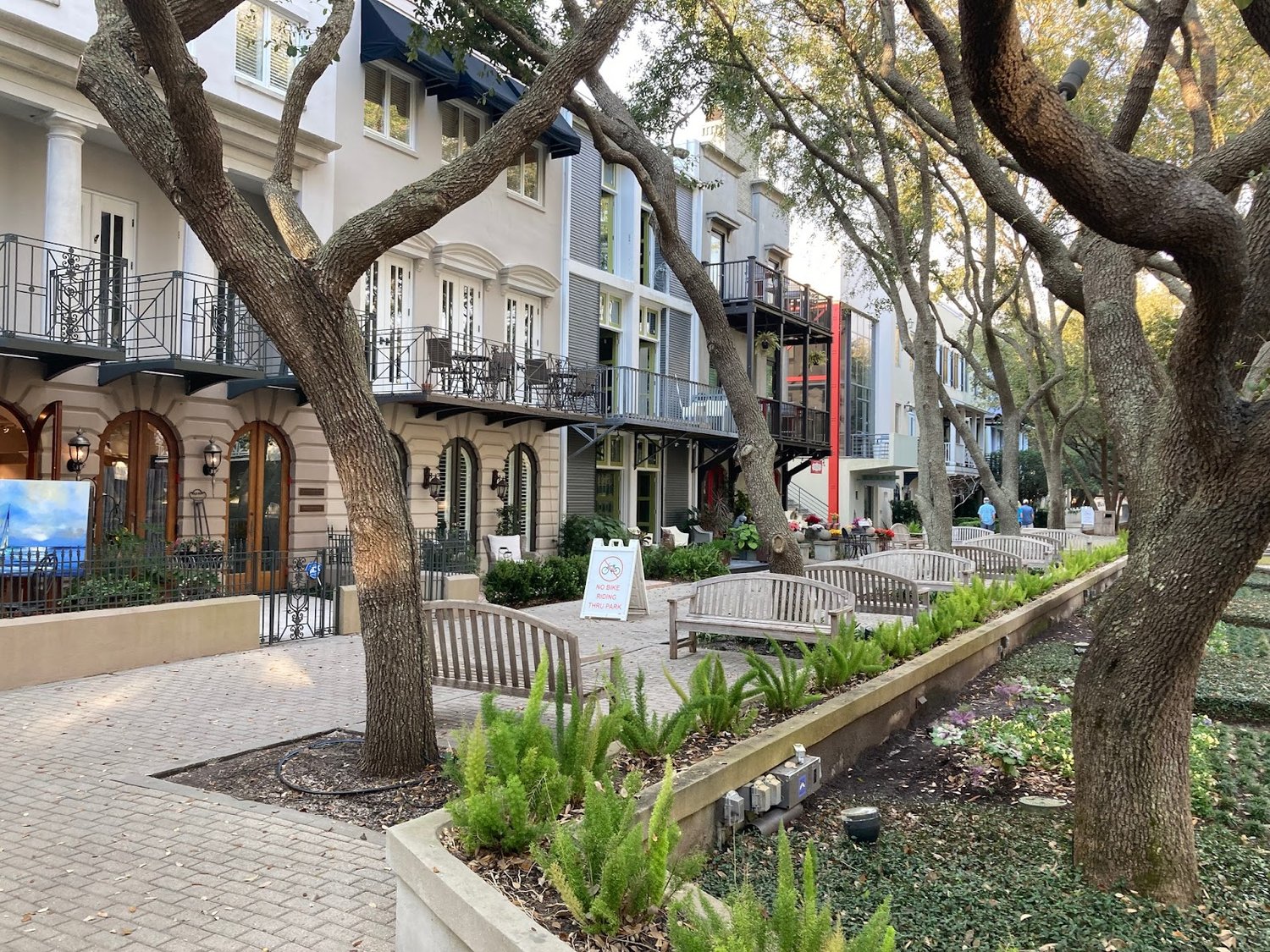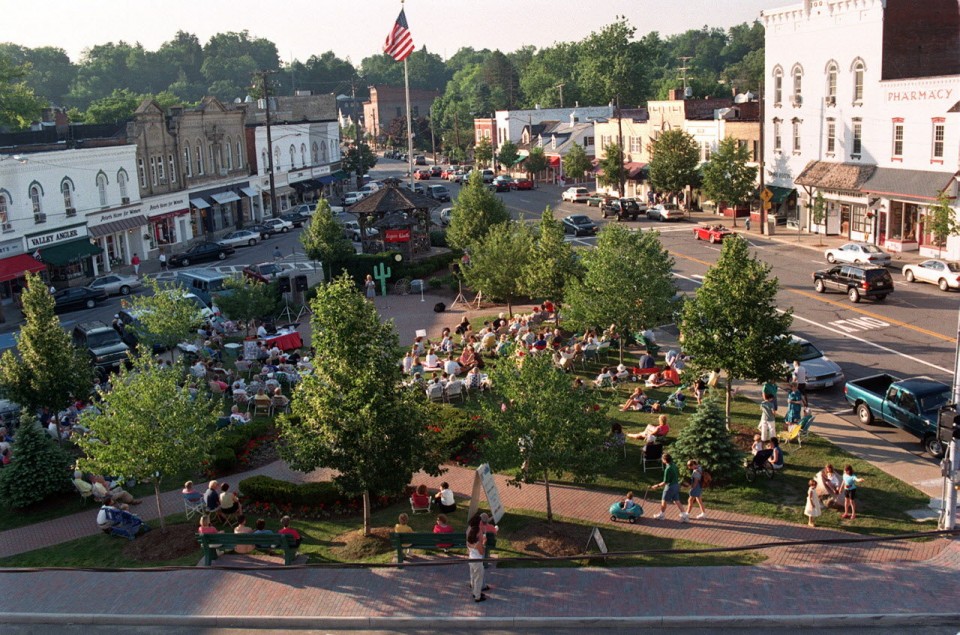Amidst hyperbolic claims by critics as well as defenders, a common-sense understanding of the basics of good cities and towns—and their opposite—is getting lost in the noise.
by Michael W. Mehaffy and Nikos Salingaros (March 2023)

Watermill in Pont-Aven, Paul Gauguin, 1894
Planners are often, and often rightly, criticized for their heavy-handed, failed schemes for cities and towns. The urban scholar Jane Jacobs, for example, famously offered withering criticism of the “pseudoscience” of planning, which “seems almost neurotic in its determination to imitate empiric failure and ignore empiric success.” Looking back at the wreckage of many cities over the last half-century, one finds good reason to be suspicious of new schemes.
Comes now the concept of the “15-minute city,” the latest talk of the town in planning circles. This model of urban design proposes including all the necessary amenities, such as education, employment, healthcare, housing, and recreation, within a fifteen-minute walk or bike ride of any given point within a city. The idea has gained traction among policymakers and urbanists alike because of the perceived (or claimed) benefits it offers in improving the residents’ quality of life, enhancing social cohesion, reducing carbon emissions, and other benefits.
But is this just another heavy-handed scheme of bureaucratic overreach by planners? Given the recent hyperbolic criticism of the concept, one might think so. Indeed, the 15-minute city seems to be the latest “specter haunting the world” —yet another evil bureaucratic fantasy that limits choices and forces people into conformity. Ordinary citizens, it is claimed, just want to be left alone to the car-centric lifestyles they have chosen, as a natural and inevitable outcome of a free market.
This is nonsense. Our cities are already the product of massive bureaucratic overreach, stretching back many decades. If you want to find a government plot, look no further: the car-centric urbanism and suburbanism that exists in many cities today is the direct result of government-enforced segregated-use zoning, discriminatory mortgage lending rules, vast expenditures for freeway construction, ugly car-oriented engineering codes, and a byzantine system of tax subsidies and other incentives.
Certainly, the car-centric system has delivered benefits, including huge profits to the specific industries involved. Many people do enjoy the conveniences of a drive-through lifestyle, and the car has made it possible for people to access job opportunities and other resources that they couldn’t before, or couldn’t without difficulty—lifting them out of poverty, and providing other significant benefits.
But this car-dependent system has its drawbacks, evident to more people as time goes on: the increasing cost of car ownership and operation, increasing traffic congestion (stubbornly resistant to endless and expensive road-widening projects), traffic-related deaths and injuries, and the sheer amount of time stuck in traffic for increasing numbers of urban residents.
Speaking of freedom of choice, decades of urban zoning decisions have robbed citizens of actual choice about how to get around, and forced them into cars—regardless of the cost or hardship that may produce for those who can’t or don’t want to drive. Those who do try to walk or bike (including children) are forced to navigate dangerous streets prioritized for fast-moving cars.
There has also been a cost to neighborhood livability and sociability, as people became more isolated from each other, and less able to interact face-to-face. Research has shown that this social isolation has reduced the levels of trust and cooperation between people, and even resulted in higher rates of death and illness during urban crises, like the 1995 Chicago heat wave.
Perhaps less obvious are the costs to taxpayers and citizens: vastly more infrastructure construction and maintenance, longer distances for municipal services, and other “externality costs” —pollution, resource depletion, health impacts, and others, that hit us all in the pocketbook sooner or later. Indeed, some conservative critics have even called this system a “Ponzi scheme” for its hidden long-term and potentially catastrophic costs to citizens.
That’s one reason that people across the ideological spectrum have called for a rethink of car-dominant planning and transportation systems. Few are suggesting to get rid of the car any time soon. However, many people from diverse constituencies are saying that we need to re-balance the equation, and offer more choice in how to get around—not only by car, but also by walking, biking, and using transit. And we also need to have more choices nearby that we can access by walking or biking within a reasonable amount of time. Enter the “15-minute city” concept.

The 15-minute city is actually a relatively new name for a very old model: the “urban village,” or the mixed-use neighborhood … or good old-fashioned “Main Street USA.” This kind of neighborhood grew up naturally, when people didn’t have fast automobiles, and needed to have a reasonable number of destinations within walking distance. In many of today’s most desirable (and valuable) communities in the US and elsewhere, these “urban villages” are still operational, or have been newly built: traditional towns like Georgetown, Mendocino or Annapolis, or new towns like Seaside, Florida, Seabrook, Washington, or Daybreak, Utah. Here, the quality and design of public space has a significant impact on the city’s livability and vibrancy, and emphasizes the need for visually interesting and inviting public spaces that are accessible and inclusive to all residents.
These places are often expensive, and/or they’re popular with tourists, simply because they’re desirable and in demand—and there just aren’t very many of them yet to meet that demand. Within big cities, there are many more such urban villages (like New York, London, or Paris) —but they too are often very expensive, and increasingly exclusive. But why should only the wealthy enjoy livable, healthy neighborhoods?
By reducing commute times, promoting active transportation, and creating a walkable mix of attractive destinations, the fifteen-minute city can save money, help reduce stress, and improve physical and mental health. Additionally, this model of urban design can enhance economic opportunities for local small businesses, by promoting the development of local neighborhood-based shops and offices. But like the early cell phones, the current generation of new and expensive models would benefit from economies of scale and standardization—in other words, they need to become easier and cheaper to build.
That in a nutshell is the proposal for 15-minute cities. There have been a number of versions of this concept over the last few decades, including the “20-minute city,” the walkable mixed-use neighborhood of the “New Urbanism,” and other less-known variants. But the concept has become famous of late because of the work of Professor Carlos Moreno of the Sorbonne in Paris, and his work with the Paris city government to build on the concept. Moreno has become a popular promoter of the concept in other cities too, including Milan, Melbourne, and Chengdu, China.
Importantly, Moreno is not an urban planner, but a professor of complex systems with an education in mathematics, robotics, and information technology. His view of cities is therefore interdisciplinary by nature, and focused on cities as complex systems—not as the wishful (and often willful) constructs of planners. Indeed, he shares many of the great urban journalist Jane Jacobs’ criticisms of the planning profession, and its habit of “field-of-dreams planning”, as in “plan it and they will come.” As Jacobs observed, this way of thinking fails to understand “the kind of problem a city is” —a problem in market dynamics, certainly, but also one of “polycentric governance,” meaning not only government but active stewardship by institutions and citizens of their own public realm.
On the other hand, city planners do have the opportunity—and the obligation, it would seem—to get the framework of a living neighborhood right, to give people a choice in how to get around, and to have access to routine services, parks, and quality of life, within their own neighborhoods. Unfortunately, this is not for the most part what planners have been giving us for the last half-century.
Some would object here that planners can’t force businesses to operate small, marginally profitable stores in every neighborhood, or force people to work close to home, or force people who prefer cars onto skinny streets prone to traffic jams. This is where pragmatic problem-solving coupled with thinking incrementally has to come into play. Not every destination needs to be fifteen minutes away by bike or foot—but many of them can be, as good examples demonstrate. And smaller retail formats can be profitable, depending on catchment and visibility, and spurred by tax breaks (instead of being driven out by onerous overheads).
Moreover, a neighborhood can improve over time, offering more diverse amenities and interesting destinations. History shows that if the proper codes are in place, coupled with the right amount of openness, the complex urban fabric will evolve into a spontaneous form of mixed use, without needing heavy-handed impositions.
We should also be wary of the common fallacy that density is the enemy of livability. Indeed, some low-density neighborhoods are horrible places, while higher-density ones are charming and popular (think of appealing tourist destinations). The issue is not density per se, but the quality of urban design, and the degree to which the design allows residents to choose privacy versus contact. A good design adapts to human dimensions, movement, and psychology and provides the best of both worlds—the ability to be secluded when needed, and the ability to access lively, well-attended neighborhood amenities. (It is also sadly true, however, that few of today’s architects and planners are trained in the skills necessary to produce such coherent designs—but that’s the subject of another article!)
But what if these 15-minute neighborhoods become inward-turning enclaves, excluding too many outsiders? That is already a problem with our existing housing monocultures and gated communities, especially in the car-dependent suburbs—and it stems from a failure to understand the idea of “polycentric neighborhoods.” These are neighborhoods and neighborhood clusters that connect and overlap, allowing fluid movement across them, especially on foot.

A good neighborhood framework can deal with the problem of balancing access with privacy, and we have seen it happen repeatedly throughout history. In essence the goal is to create centers as well as edges, where movement and interaction can occur. The best cities also have big centers that overlap with little ones, creating a more fluid, connected urban fabric. If something interrupts that fabric—a cut-off neighborhood, or a big urban complex, or even a natural feature—then the goal ought to be to weave it back into the urban fabric, as Jane Jacobs sagely advised.
Another double-edged sword concerns the gentrification of existing neighborhoods. In part, this is a simple problem of balancing demand with supply—with more homes, but also more of the walkable mixed neighborhoods that are in increasing demand, in more places. This is the idea of a “polycentric region”: not only the cores should be walkable and well-connected, but so should all the neighborhoods across the region.
As new housing and commercial spaces are developed, we also need significant investments in livable neighborhood infrastructure, including viable public transportation, bike infrastructure, and generous sidewalks. The growth of new local housing and commercial spaces in new centers as well as “gentle densification” in existing neighborhoods (preserving the beauty and livability of existing places) will yield significant returns in terms of economic growth.
People across ideological divides ought to be able to agree that choice is a good thing, and that diversity of neighborhood choices within access (and with a choice of modes of travel) is a worthy goal. The dynamic network city, balancing choice with coherent “rules of the game,” is a liberating model, not an oppressive one.
We can also agree that a mindless bureaucracy that enforces conformity in the pursuit of an imagined utopia is not a good thing, and ought to be challenged. What is needed is pragmatism, coupled with a deeper understanding of the characteristics we seek in the most livable neighborhoods of history.
Further Reading:
Christopher Alexander (2005) The Nature of Order, Volume 3: A Vision of A Living World, Center for Environmental Structure, Berkeley, CA.
Nir Haim Buras (2020) The Art of Classic Planning: Building Beautiful and Enduring Communities, Belknap Press, Cambridge, MA.
Andrés Duany and Robert Steuteville (2021) Defining the 15-minute city, Public Square CNU, 8 February. https://www.cnu.org/publicsquare/2021/02/08/defining-15-minute-city
Andrés Duany and Robert Steuteville (2022) From slogan to substance, planning the 15-minute city, Public Square CNU, 13 December. https://www.cnu.org/publicsquare/2022/12/13/slogan-substance-planning-15-minute-city
Jane Jacobs (1961) The Death and Life of Great American Cities, Vintage Books, New York, NY.
Léon Krier (2009) The Architecture of Community, Island Press, Washington, DC. Older edition: Architecture: Choice or Fate, Andreas Papadakis, Windsor, UK, 1998.
Michael Mehaffy and Nikos Salingaros (2015) Design for a Living Planet, Sustasis Press, Portland, Oregon, USA and Vajra Publications, Kathmandu, Nepal.
Carlos Moreno, Zaheer Allam, Didier Chabaud, C. Gall and F. Pratlong (2021) Introducing the “15-Minute City”: Sustainability, Resilience and Place Identity in Future Post-Pandemic Cities, Smart Cities, Volume 4, No. 1, 93-111. https://doi.org/10.3390/smartcities4010006
Nikos A. Salingaros (2005) Principles of Urban Structure, Techne Press, Amsterdam, Holland and Sustasis Press, Portland, Oregon.
Nikos A. Salingaros (2006) Compact City Replaces Sprawl, Chapter in: Crossover: Architecture, Urbanism, Technology, Edited by Arie Graafland and Leslie Kavanaugh, 010 Publishers, Rotterdam, Holland, pages 100-115. http://www.academia.edu/188203/Compact_City_Replaces_Sprawl
Lucien Steil, Nikos A. Salingaros and Michael W. Mehaffy (2008) Growing Sustainable Suburbs: An Incremental Strategy for Reconstructing Sprawl, Chapter 10.2 in: New Urbanism & Beyond: Designing Cities for the Future, Tigran Haas, Editor, Rizzoli, New York, NY, pages 262-274. https://www.academia.edu/188207/Growing_Sustainable_Suburbs_An_Incremental_Strategy_for_Reconstructing_Sprawl
Robert Steuteville (2023) The 15-minute city, why does it matter? A theoretical framework based on walking and bicycling sheds makes the 15-minute city more useful to cities and planners, Public Square CNU, 31 January. https://www.cnu.org/publicsquare/2023/01/31/15-minute-city-why-does-it-matter
Table of Contents
Dr. Michael W. Mehaffy is Executive Director of the Lennard Institute for Livable Cities, host of the International Making Cities Livable (IMCL) conference series. He is also Executive Director of the Oregon-based Sustasis Foundation, and an internationally active educator, author, and consultant, with current or former appointments at eight universities in seven countries. He is also an active designer, planner, builder and/or developer of gardens, homes, businesses, neighborhoods, and city areas.
Dr. Nikos A. Salingaros is Professor of Mathematics and Architecture at the University of Texas at San Antonio. An internationally recognized urbanist and architectural theorist, he collaborated with visionary architect and software pioneer Christopher Alexander. Salingaros won the 2019 Stockholm Cultural Award for Architecture, and shared the 2018 Clem Labine Traditional Building Award with Michael Mehaffy.
Follow NER on Twitter @NERIconoclast
- Like
- Digg
- Tumblr
- VKontakte
- Buffer
- Love This
- Odnoklassniki
- Meneame
- Blogger
- Amazon
- Yahoo Mail
- Gmail
- AOL
- Newsvine
- HackerNews
- Evernote
- MySpace
- Mail.ru
- Viadeo
- Line
- Comments
- SMS
- Viber
- Telegram
- Subscribe
- Skype
- Facebook Messenger
- Kakao
- LiveJournal
- Yammer
- Edgar
- Fintel
- Mix
- Instapaper
- Copy Link







2 Responses
I’ve found myself both sympathetic and opposed to both Robert Moses’ and Jane Jacobs’ ideas for decades, both being characterizable as political, social, and architectural progressives albeit illustrative of two different traditions within.
I’d like to find a model somewhere without and between them. I don’t mind capitalism, real estate development and a modern city, I like both transit and roads and cars, I don’t mind nice skyscrapers, but I can do without walls of lazily thrown up condo and office towers, nondescript poor cousins of the occasional appealing international style roots, post modern design that just throws things together for the sake of shock instead of the few decent examples of the form in every major city. I like transit, I can do without it being mandatory and a social icon. I like roads, even throughways, but I can do without them destroying everything. I like a lot of green, but I’ve also heard a teacher back in the 80s claim my native Toronto lacked parkland. That statement was overwrought. I like pedestrian routes [I am mostly a pedestrian and busman in real life] but I don’t need every sidewalk to be triple the traditional width, nor many streets closed off. I like restaurants and patios, I don’t need them omnipresent. I will tolerate bikes. I have no love for cyclists. As a pedestrian, they are my chief enemy.
I like the idea of a sense of community and neighbourhood, as long as I don’t need to be part of one of those old school villages or urban neighbourhoods where everyone knows my business. I want people to also have the option of detached houses and yards and privacy combined with fresh air and their own private patch of green. I even want them to be able to live isolated in a condo if they want, as long as the buildings don’t colonize all land and waterfront like triffids.
In the end, we seem to be struggling between overdone archetypes of Moses and Jacobs and few options between or outside these paradigms- intrusive, privacy free urban slum with clotheslines strung over the road, or the apocalyptic nightmare of Cabrini Green.
Sounds lovely. If only that was the full story. What are they doing to create jobs in these areas? Nothing. They’re just banning cars.
And all this is brought to you by the same people who believe in climate change, an even bigger scam than covid. And the elite will continue to have private jets, while we are locked up in our zones.